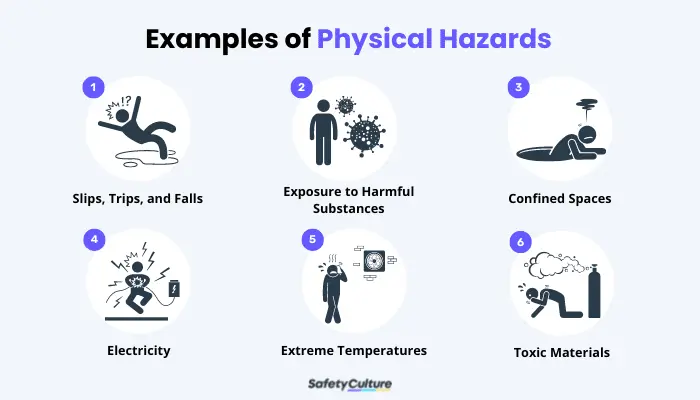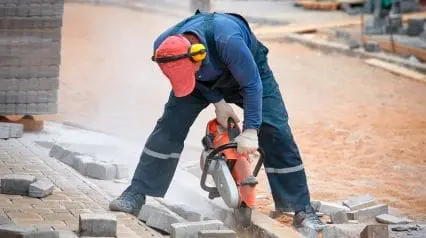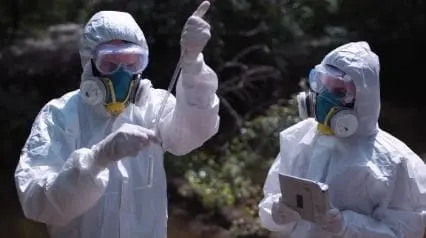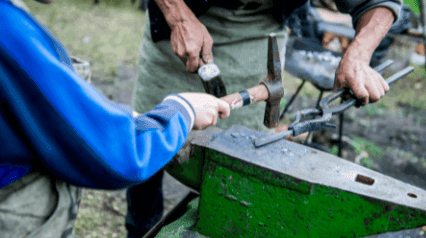What is a Physical Hazard?
A physical hazard is a factor or condition in an environment that can cause harm when it comes to contact with someone. Some common examples of physical hazards include electrical hazards, tripping hazards, and ergonomic hazards. Physical hazards can be found in both our natural environment and the workplace, including construction sites, factories, and offices.
Workplace hazards are also a common cause of physical injuries. Hence, it is important to identify physical hazards in the workplace so they can be controlled or eliminated. This can be done through various methods, such as hazard identification and dynamic risk assessment.
Once physical hazards have been identified, it is important to develop and implement controls to protect workers. Some standard rules include administrative controls, engineering controls, and Personal Protective Equipment (PPE).
5 Main Classes of Physical Hazards
According to the Health and Safety Authority (HSA), there are 5 main classes of physical hazards. These include:
1. Explosives
These substances can undergo a rapid chemical reaction that produces large amounts of gas and heat. This can lead to an explosion which can lead to fatal injuries to your body or even death. Proper precautions such as keeping a safe distance, wearing protective clothing, and avoiding ignition sources will keep workers safe from harm.
2. Oxidizing Agents
These are substances that supply oxygen to a fire to help it burns. These materials can make a fire spread and grow, which is very dangerous, especially when you are in enclosed spaces.
3. Flammable Materials
Flammable materials can easily catch on fire and burn. They can be in the form of liquids, gases, or solids. Flammables are often used in our daily lives, so it is important to be cautious when handling them.
4. Corrosive Materials
Corrosive materials can damage your skin, eyes, and respiratory tract if you are exposed to them. They can also damage metal surfaces. This is because it can eat away at materials, causing them to break down. It is important to wear proper protective gear when working with corrosive materials.
5. Gas Under Pressure
These materials contain gasses and are under pressure so that they can explode or burst. They can explode when heated and can lead to serious or fatal injuries to the body. Some examples include:
- Aerosol cans
- Propane tanks
- Butane lighters
- Oxygen tanks
Physical Hazard Examples
Many types of hazards can pose a risk to our safety and health. But what are the examples of physical hazards that can be found in a workplace?

Examples of physical hazards | SafetyCulture
Slips, Trips, and Falls
Slips, trips, and falls are the most common physical hazards. Slips and trips are often caused by wet floors, cluttered walkways, or loose carpeting. Falls can lead to serious injuries, so it’s important to be aware of these hazards and take steps to avoid them.
Exposure to Harmful Substances
This can include chemicals, fumes, and particles that can cause irritation or harm our health. It’s important to be aware of these hazards and take steps to protect ourselves from them.
Confined Spaces
Working in confined spaces can be dangerous because there is limited space to move around, and it can be difficult to breathe. If you’re working in a confined space, it’s important to take precautions to avoid any body parts being caught or stuck.
Electricity
Electricity is a physical hazard that can cause burns, shocks, or even death. It’s important to be aware of this hazard and take steps to protect ourselves from it. Make sure to inspect any wet areas before dealing with electricity. Lastly, wearing proper PPE is essential to prevent any unexpected electrocutions.
Extreme Temperatures
Working in extreme temperatures can be dangerous because our bodies can’t regulate the temperature well in these conditions. If you’re working in extreme heat or cold, it’s important to take steps to stay cool or warm and stay hydrated.
Toxic Materials
Toxic materials can hurt your body or even kill you if you are exposed to high concentrations of them. These hazards can be in the form of gases, liquids, or solids. It is important to wear proper protective gear when working with toxic substances.
Other common physical hazard examples include:
- Body stressing
- Low lighting or poor visibility
- Moving machinery or vehicles
- Constant and sudden high noise levels
- Fire hazards (such as flammable materials or inadequate fire exits)
- Physical violence or assault
- Ergonomic hazards
- Sharp objects or tools
- Ultraviolet rays exposure
- Hand/arm vibration and whole-body vibration



